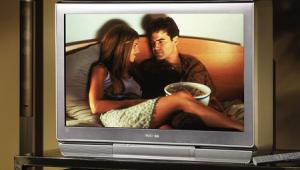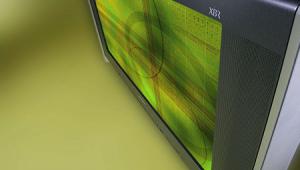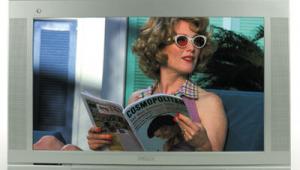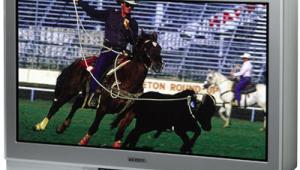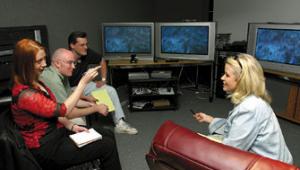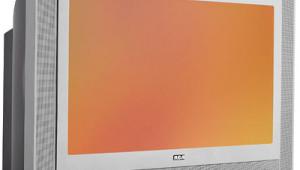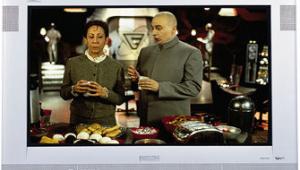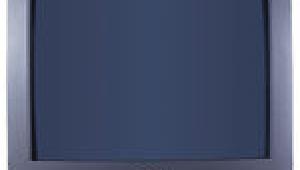The 2002 Direct-View HDTV Face Off Philips 34PW9818
My father always says, "Do one thing, and do it well." Philips seems to have taken this advice to the extreme with their 34PW9818. The company has fared well under the scrutiny of the Home Theater staff in the past, and their new model adds the company's Pixel Plus processing to the picture. This feature alone nearly propelled this 34-inch display to take top honors in our anything-goes death match.
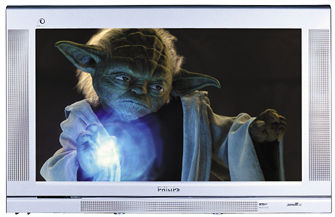
The 34PW9818 does have some other positive attributes, like the plethora of connection options on back that will accommodate nearly any home theater rig, although the raised black letters on the black background make it difficult to see what's what. The inclusion of both an RGB input and three Y/Pb/Pr inputs makes the set particularly flexible. Only two of these inputs accept progressive-scan DVD and HDTV signals, though. No 720p for ABC fans. Sorry. There's also no aspect-ratio control for 480p sources, which is a drag, since the display's internal video processor doesn't seem to use any 3:2-pulldown compensation, either. The upconversion processing does a better job in the Pixel Plus mode than it does in the progressive mode, but motion artifacts are still present with video material (contrary to what other publications lead you to believe). There are no digital video connections like DVI or IEEE 1394, which is a bit of a letdown in terms of future compatibility (see my sidebar on digital connections in the March 2002 rear-projection HDTV Face Off). Also, if you lose sync from your external source, the display gives you a blank blue screen until you reselect the correct input. An additional input on the front panel provides easy access for camcorders and video-game machines.
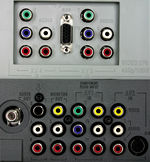 Fortunately, Philips provides the 34PW9818 with sufficient memory to adjust and store settings for the various inputs separately. The TV's controls allow you to adjust picture parameters with reasonable accuracy. For example, the set's color decoder pushes red slightly with test patterns; but, with regular video, the panelists didn't object. Chris pointed out that the Philips was slightly more yellow than the other displays, mainly due to the color-temperature control's low setting. The normal setting was too blue, while the warm setting was too red. After calibration, Chris found the image to be much more pleasing. The set's DC restoration is more or less stable. Dark images stay dark with changing picture material, and there was no apparent scan-velocity modulation (SVM), which usually distorts the picture.
Fortunately, Philips provides the 34PW9818 with sufficient memory to adjust and store settings for the various inputs separately. The TV's controls allow you to adjust picture parameters with reasonable accuracy. For example, the set's color decoder pushes red slightly with test patterns; but, with regular video, the panelists didn't object. Chris pointed out that the Philips was slightly more yellow than the other displays, mainly due to the color-temperature control's low setting. The normal setting was too blue, while the warm setting was too red. After calibration, Chris found the image to be much more pleasing. The set's DC restoration is more or less stable. Dark images stay dark with changing picture material, and there was no apparent scan-velocity modulation (SVM), which usually distorts the picture.
Navigating the Philips' menu is a unique experience. The menu is well laid-out, and the graphics are extremely well done, but the extended menu-tree format can be slow. Ron liked it, though, and figures that the occasional user will benefit from the structure's graphic road map. The aspect-ratio menu has an auto setting that suggests that the display might automatically detect anamorphically recorded DVD signals and switch to the appropriate picture mode. Sadly, this isn't so. It just detects letterboxed images, anamorphic or not, and expands them.
 The remote, like the menu, got fairly high marks from some of the staff. The long, slender control's elegant silver finish appealed to both Maureen and Claire. The control functions are reasonably well arranged, although Geoffrey thought that some of them were too far apart. You also don't get discrete input or power commands, which makes it difficult to program universal remotes like (ironically) Philips' Pronto. None of the other sets (except Toshiba's) had these features, either.
The remote, like the menu, got fairly high marks from some of the staff. The long, slender control's elegant silver finish appealed to both Maureen and Claire. The control functions are reasonably well arranged, although Geoffrey thought that some of them were too far apart. You also don't get discrete input or power commands, which makes it difficult to program universal remotes like (ironically) Philips' Pronto. None of the other sets (except Toshiba's) had these features, either.
Performance-wise, the Philips fared well, although opinions were varied. There was no denying that the picture was razor-sharp. The image had incredible detail in nearly every scene. The video processing, called Pixel Plus, is what drew ire or praise from the crowd. In addition to doubling the number of lines vertically, or turning the 480i image into 480p, Pixel Plus doubles the number of pixels in each horizontal line. (This is similar in theory to Sony's DRC processing.) Something in the way Philips does this makes a good image look like HDTV. This was particularly noticeable with our Training Day DVD. About 11 minutes into the film, Denzel Washington and Ethan Hawke are driving over a bridge or overpass. The railing on the left had much more detail on the Philips than on any other set. The image also appeared to have much smoother motion. Maureen, Ron, and I appreciated the more-realistic look, while Chris, Claire, and Geoffrey felt that it just made film-based sources look like really good video. The Pixel Plus processing can produce some artifacts that are more evident when you sit close to the TV. Using the TV's soft mode might alleviate these artifacts somewhat, but this mode doesn't allow you to adjust the picture controls.
Although it lacks a couple of the other sets' nice features, the Philips 34PW9818 offers an outstanding image. Some of the panelists weren't crazy about what Pixel Plus does for the picture, and you can disable it, if you want. Then again, if you do, there may not be much point in owning this TV. Other panelists, myself included, were simply awestruck with the 34PW9818's level of detail and smooth, natural image motion. Ron even gave this TV his number-one nod. If nothing else, I'd love to see Philips offer this video processor separately.

34PW9818 HD Monitor $2,999
Philips Consumer Electronics
(800) 531-0039
www.philipsusa.com
Dealer Locator Code PHL
Highlights
• Pixel Plus processing
• Razor-sharp detail
HT Labs Measures: Philips 34PW9818

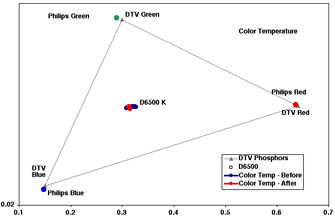
The top chart shows the gray scale of the 34PW9818 HD monitor as set by the manufacturer in the low color-temperature setting. The set measures 6,300 Kelvin with dark images and leans more toward 5,700 K with brighter images. After making adjustments using the Photo Research PR-650, the gray scale measures within 100 degrees of D6500, the accurate setting, across the entire range. The bottom chart shows that the primary colors of the display's CRTs are extremely close to those specified by SMPTE. This means that the display will accurately reproduce nearly all of the colors available in the system. The gray scale measures red before calibration and is extremely accurate afterward. The light output was approximately 36 foot-lamberts. The display has good DC restoration. The set's color decoder pushes red, but only slightly, and it displays about 1,150 horizontal pixels with the 1080i test pattern from our Leader LT-446 HDTV test-pattern generator.—MW
- Log in or register to post comments
